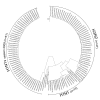Genetic divergence of influenza A NS1 gene in pandemic 2009 H1N1 isolates with respect to H1N1 and H3N2 isolates from previous seasonal epidemics
- PMID: 20809948
- PMCID: PMC2936903
- DOI: 10.1186/1743-422X-7-209
Genetic divergence of influenza A NS1 gene in pandemic 2009 H1N1 isolates with respect to H1N1 and H3N2 isolates from previous seasonal epidemics
Abstract
Background: The Influenza A pandemic sustained by a new H1N1 variant (H1N1v) started in Mexico and the USA at the end of April 2009 spreading worldwide in a few weeks. In this study we investigate the variability of the NS1 gene of the pandemic H1N1v strain with respect to previous seasonal strains circulating in humans and the potential selection of virus variants through isolation in cell culture.
Methods: During the period April 27th 2009-Jan 15th 2010, 1633 potential 2009 H1N1v cases have been screened at our center using the CDC detection and typing realtime RT-PCR assays. Virus isolation on MDCK cells was systematically performed in 1/10 positive cases. A subset of 51 H1N1v strains isolated in the period May-September 2009 was selected for NS1 gene sequencing. In addition, 15 H1N1 and 47 H3N2 virus isolates from three previous seasonal epidemics (2006-2009) were analyzed in parallel.
Results: A low variability in the NS1 amino acid (aa) sequence among H1N1v isolates was shown (aa identity 99.5%). A slightly higher NS1 variability was observed among H1N1 and H3N2 strains from previous epidemics (aa identity 98.6% and 98.9%, respectively). The H1N1v strains were closely related (aa identity 92.1%) to swine reference strain (A/swine/Oklahoma/042169/2008). In contrast, substantial divergence (aa identity 83.4%) with respect to human reference strain A/Brevig Mission/1/1918 and previous epidemic strains H1N1 and H3N2 (aa identity 78.9% and 77.6%, respectively) was shown. Specific sequence signatures of uncertain significance in the new virus variant were a C-terminus deletion and a T215P substitution.
Conclusions: The H1N1v NS1 gene was more conserved than that of previous epidemic strains. In addition, a closer genetic identity of H1N1v with the swine than the human reference strains was shown. Hot-spots were shown in the H1N1v NS1 aa sequence whose biologic relevance remains to be investigated.
Figures


References
Publication types
MeSH terms
Substances
Associated data
- Actions
- Actions
- Actions
- Actions
- Actions
- Actions
- Actions
- Actions
- Actions
- Actions
- Actions
- Actions
- Actions
- Actions
- Actions
- Actions
- Actions
- Actions
- Actions
- Actions
- Actions
- Actions
- Actions
- Actions
- Actions
- Actions
- Actions
- Actions
- Actions
- Actions
- Actions
- Actions
- Actions
- Actions
- Actions
- Actions
- Actions
- Actions
- Actions
- Actions
- Actions
- Actions
- Actions
- Actions
- Actions
- Actions
- Actions
- Actions
- Actions
- Actions
- Actions
- Actions
- Actions
- Actions
- Actions
- Actions
- Actions
- Actions
- Actions
- Actions
- Actions
- Actions
- Actions
- Actions
- Actions
- Actions
- Actions
- Actions
- Actions
- Actions
- Actions
- Actions
- Actions
- Actions
- Actions
- Actions
- Actions
- Actions
- Actions
- Actions
- Actions
- Actions
- Actions
- Actions
- Actions
- Actions
- Actions
- Actions
- Actions
- Actions
- Actions
- Actions
- Actions
- Actions
- Actions
- Actions
- Actions
- Actions
- Actions
- Actions
- Actions
- Actions
- Actions
- Actions
- Actions
- Actions
- Actions
- Actions
- Actions
- Actions
- Actions
- Actions
- Actions
LinkOut - more resources
Full Text Sources
Miscellaneous

